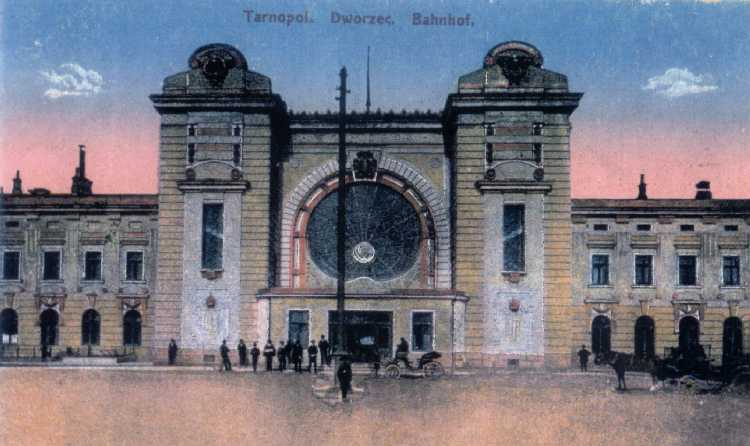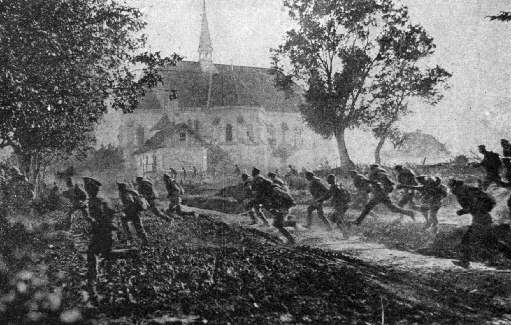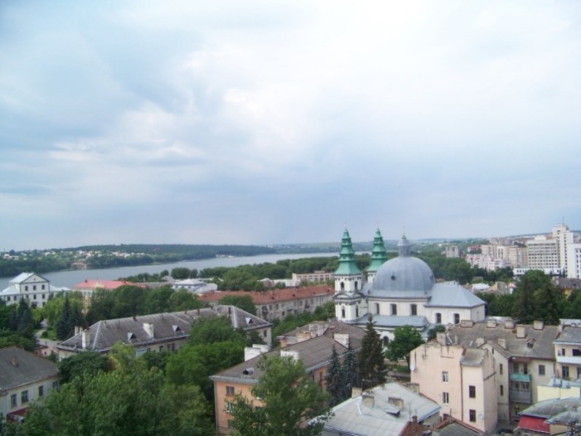This is blog about Eastern Europe and its people . I write about family members who immigrated from Eastern Europe and include cultural and historic material about the countries where my families originated.
Friday, September 26, 2014
Friday, September 19, 2014
"Rise, Rise for Evanston"
 |
| Evanston Township High School today, |
Last weekend I attended my 50th High School Class Reunion. I graduated from Evanston Township High School in June 1964. Our class was large, almost 800 students in the class, about 300 attended the Reunion. The class had many bright and accomplished students, many attended Ivy League and other prestigious universities. Many went on to graduate and professional schools. There were high hopes for our class, and for the most part, the hopes were realized.
 |
| Evanston Township High School in 1964, pictured in our yearbook, the Key |
All of us came from the towns of Evanston and Skokie, Illinois. We were fortunate to attend such a fine high school, and even more fortunate to live in these great towns. In the 1960's Evanston was the "headquarters" city, home to many corporations. It is also the home of Northwestern University. It was known as a city of 'Homes, schools and churches" many of architectural significance. It was a great place to raise a family, there were plenty of things for children to do, beautiful parks, Lake Michigan beaches, and only a short train ride from Chicago. In 1964, Our high school was considered one of the best in the nation and still is today.
 |
| Evanston was one of the high schools featured in Look Magazine in 1964. |
 |
| Graduating seniors |
 |
| Commencement Program |
 |
| I was on the yearbook staff in 1964 |
| The Washington Post picked Evanston High School as one of American most challenging High schools in 2013. |
 |
| Evanston Township High School was picked a one of the top high schools in 2014 |
Saturday, September 13, 2014
What's My Name?
My surname is Noznick--or is it?
My surname has been problematic for most of my life. It is often mispronounced unintentionally, and sometimes intentionally. I have had some strange nicknames derived from my last name--like nozzie or just noz. So I always assumed that when I married, I would change my name immediately. But, I didn't. My husband's surname, Gerstein, is fairly common, easy to spell and pronounce. So why didn't I change? When I got married, in 1981, many women did not change their names when they married, and I was also a bit lazy, so I just kept the status quo.
Now I will get to the interesting part. In spite of keeping this surname, I have found out in my genealogical research, that Noznick isn't my family surname at all. My real surname is Nyznyk.
Many people assume that surnames were changed when people went through Ellis Island--but actually that didn't happen. An immigrant's name was recorded on ships' manifests at the port of embarkation, and written according to the immigrant's passport. When the person got to Ellis Island, that manifest was copied, often in longhand, and the immigrant's personal information was recorded. From what I have seen, nothing was changed at this time.
Many immigrants changed, shortened or Americanized their names after they were in the United States. On my side of the family, my mother's family name went from Kociuba to Koshuba. My grandmother's surname, Rychlyj, was changed to either Rychly or Rychley. In my husband's family, his grandmother's surname was changed from Monkovski, to Markin by some cousins. Karbovsky was changed to Krause in the 1930's. In the Gerstein family, his great Aunt's Biele Schwartz's married name was changed from Mankevetsky---to Mancoff. Her first name became Becky.
So, how did Nyznyk become Noznick? First of all, there is no evidence that the name was legally changed. My father found this out when he applied for a passport in 1965. He found no records under Peter Paul Noznick,
born August 18, 1915, in New York City. He made a trip to New York
City to locate information that would prove his identity. He found his
birth certificate, his last name was spelled Nausneck--no
first name listed. More searching located his baptismal certificate
and his parent's marriage license. On both of these documents the name
was spelled Nyznyj. His father's name was written in Latin as Ionnes Nyznyj--in English he was John Nyznyk. My Dad still could not prove that Peter Paul Nyznyj was Peter Paul Noznick.
I came across on of my Dad's report card with his name listed as Noznick. He signed his mother's name to the card as Mary Noznick. In 1930, she was married to Peter Zackowski and was known as Mary Zackowski. In the 1930 census, I found the Noznick
family at 624 E. Eleventh St, NYC, which was the address where my Dad
told me he lived. I believe that my Dad gave the census taker the information since both his parents worked three jobs, and were not at home. The head of the house was listed as John Noznick, wife as Mary Noznick and son as Peter Noznick. According to his application for US citizenship, dated 1930, my Dad's father, John Nyznyk, lived at 533 E. 6th St, his occupation was upholsterer. But In the
1960's, the 1930 Census information was not available and my father did not know that his father applied for United States citizenship.
How did he solve the problem of establishing his identity? He did get the passport and made the trip abroad. He obtained an affidavit stating that he was Peter Noznick and had been known by that name since high school.
How did Nyznyk become Noznick? The fact that his mother was illiterate, and did not speak English very well may have contributed to the transformation of nyznyk to noznick. Since the name sounded a bit like noznick, he became Peter Noznick. Perhaps the teachers knew of the Noznick family, who lived in New York City, and spelled my dad's surname in a was that was familiar to them. My Dad's father was literate, so his name was never changed, misspelled or mangled like my Dad's was.
So what about the Noznick surname? It is an uncommon name, but as I researched my family history, I found there were several Noznick families living in New York City. I have no idea what their ethnic background was, and I have found no family connection with any of these people.
My surname has been problematic for most of my life. It is often mispronounced unintentionally, and sometimes intentionally. I have had some strange nicknames derived from my last name--like nozzie or just noz. So I always assumed that when I married, I would change my name immediately. But, I didn't. My husband's surname, Gerstein, is fairly common, easy to spell and pronounce. So why didn't I change? When I got married, in 1981, many women did not change their names when they married, and I was also a bit lazy, so I just kept the status quo.
Now I will get to the interesting part. In spite of keeping this surname, I have found out in my genealogical research, that Noznick isn't my family surname at all. My real surname is Nyznyk.
Many people assume that surnames were changed when people went through Ellis Island--but actually that didn't happen. An immigrant's name was recorded on ships' manifests at the port of embarkation, and written according to the immigrant's passport. When the person got to Ellis Island, that manifest was copied, often in longhand, and the immigrant's personal information was recorded. From what I have seen, nothing was changed at this time.
Many immigrants changed, shortened or Americanized their names after they were in the United States. On my side of the family, my mother's family name went from Kociuba to Koshuba. My grandmother's surname, Rychlyj, was changed to either Rychly or Rychley. In my husband's family, his grandmother's surname was changed from Monkovski, to Markin by some cousins. Karbovsky was changed to Krause in the 1930's. In the Gerstein family, his great Aunt's Biele Schwartz's married name was changed from Mankevetsky---to Mancoff. Her first name became Becky.
 |
| Peter Noznick in Central Park, NYC,about 1930. |
 |
| 1930 United States Census, listing the Noznick family. |
 |
| John Nyznyk's application for US Citizenship, 1930. |
How did he solve the problem of establishing his identity? He did get the passport and made the trip abroad. He obtained an affidavit stating that he was Peter Noznick and had been known by that name since high school.
 |
| My Dad in the 1934 Crystal, the yearbook of Windham High School. |
How did Nyznyk become Noznick? The fact that his mother was illiterate, and did not speak English very well may have contributed to the transformation of nyznyk to noznick. Since the name sounded a bit like noznick, he became Peter Noznick. Perhaps the teachers knew of the Noznick family, who lived in New York City, and spelled my dad's surname in a was that was familiar to them. My Dad's father was literate, so his name was never changed, misspelled or mangled like my Dad's was.
So what about the Noznick surname? It is an uncommon name, but as I researched my family history, I found there were several Noznick families living in New York City. I have no idea what their ethnic background was, and I have found no family connection with any of these people.
Friday, September 5, 2014
Ternopil', Ternopol, Tarnopol.
 |
| Old postcard view of Ternopil' Ukraine |
Ternopil', a city in Western Ukraine is my subject--why did I choose
this city? First of all, although none of my ancestors lived in
Ternopil', most of them came from villages near this city, as did many
other Ukrainian and Jewish immigrants to the United States. Second,
Ternopil's names give a hint of its history--Ternopil' is its Ukrainian
name, Tarnopol is the name in Polish, in Russian it is Ternopol, in
German, Tarnopol. All these powers ruled it at one time.

Ternopil' is located in Western Ukraine, in Galicia, (in Ukrainian, Halachyna), a very old and important part of Ukraine, about 70 miles east of Lviv. Ternopil' is one of the major cities of Ukraine today. It is located on the Syret River, a tributary of the Dniester River. The population was 218,614 in 2010 and about 13,000 in 1900, when many of my ancestors lived in the area. According to the Encyclopedia Britannica, Ternopil' today is a railroad junction and industrial city. Its industries include light engineering, food processing and manufacturing consumer goods. As I mentioned earlier, none of my ancestors lived in this city, but my maternal grandmother's families, the Rychlyjs and the Bryniaks, lived in Bila, a village just outside the city walls of Ternopil', about a 15 minute walk to the city center. My other ancestors, the Kocuiba (Koshuba), family lived in Ozerna, about 13 miles to the west, the Nyznyk family came from Pomorany, 30 miles west, and the Klak family lived in Zarvanytsia, about 25 miles southwest.
Galicia played an important part in Ukrainian history. Early Ukrainian history took place in Kiev, but as the influence of Kiev began to weaken, Galicia became more important. The ruler of Kiev, Volodymyr the Great (980-90) is best known for bringing Christianity to Ukraine. Volodymyr won Galicia from Poland and integrated it into his realm.
In the 13th century, Prince Danylo of Halych, a descendent of Volodymyr, took control of Galicia. During his rule he initiated several important policies in Galicia. Orest Subtely, author of Ukraine, a History (1988), said that Danylo sought the support of townspeople and peasants to offset the powers of the noblemen. In order to populate his new towns, he encouraged artisans and merchants from Poland and Germany to settle them. Armenians and Jews also came to Galicia, which developed a multi-ethnic population, that continued until the 20th century. When Galicia was conquered by the Mongols in 1246, Danylo pledged loyalty to them. This didn't stop him from establishing relations with European powers , Poland, Hungary, and Rome. Danylo died in 1264, and by working to keep the Mongol/Eastern influence out of Galicia, he turned Galicia towards Western Europe. (Subtelny pp. 61-63).
 |
| Jan Tarnowski, founder of the city of Ternopil' |
Now to Ternopil'. The city was founded in 1540 by Jan Tarnowski, a Polish nobleman. He build a walled town with a castle and a defensive moat/pond. Galicia and the city of Ternopil' were governed by various Polish kings and nobles until 1772, when they became part of the Austrian Empire in the first partition of Poland. The people of Galicia, especially Ukrainians and Jews did well under Austrian rule, and the the city of Lviv became a center of Yiddish culture and Ukrainian nationalism.
In 1870, a railroad line was built that connected Ternopil' to Lviv. Ternopil' was now connected to the major cities of the Austrian-Hungarian Empire as well as the cities of Europe. It became a railroad center and its population grew. The city of Ternopil' had a diverse population, in 1900 the city population was 28% Ukrainian, 27% Polish and 44% Jewish.
 |
| Ternopil Railroad Station |
World War One was very hard on Ternopil', as Austrian, Russian, and German armies invaded the city, its residents suffered great hardship. It wasn't far from the Russian border, and many important battles took place nearby. My Great Aunt Kathrine Pylatuik Lymar told of her village, Bila, being shelled, killing family members, destroying homes, and of having food, possessions and farm animals stolen by soldiers of the various armies. The city was burned by the retreating Russian Army in 1917. After the War ended in 1918, Ternopil' was part of Ukrainian Peoples' Republic. It was captured by Polish and Russian forces in the Polish-Soviet War. According to the Treaty of Riga,which ended the Polish-Soviet War, Galicia and Ternopil' became part of the Republic of Poland in 1920, and remained part of Poland until 1939.
 |
| Russian Soldiers Retreating from Ternopil', 1917 |
World War Two was even more destructive to Ternopil'. As a result of the Molotov-Von Ribbentrop Treaty, the Soviets and the Germans divided Poland in 1939. Western Poland came under German control and Eastern Poland, including Galicia became part of the USSR.
 |
| Planned Division of Eastern Europe, 1939 and Actual Changes 1939-1940 |
Many people were deported to Siberia and other eastern areas of the Soviet Union. In 1941, the Nazi armies invaded Galicia and Ternopil', killed most of the Jewish population and sent Ukrainians to forced labor camps in Germany. Most of Ternopil' was destroyed in 1944. After the war, many Polish residents of eastern Galicia, including my great Uncle Andrei Klak and his family, relocated to Western Poland, near the city of Wroclaw. Wroclaw had been part of Germany, known as Breslau. One of the results of the destruction of World War II was that very few buildings in Ternopil' survived, so the city was rebuilt. Ternopil' remained part of the Soviet Union until 1991, when the Soviet Union dissolved and Ukraine became an independent country.
 |
| Ternopil' today. Source: The Encyclopedia of Ukraine. |
Subscribe to:
Posts (Atom)